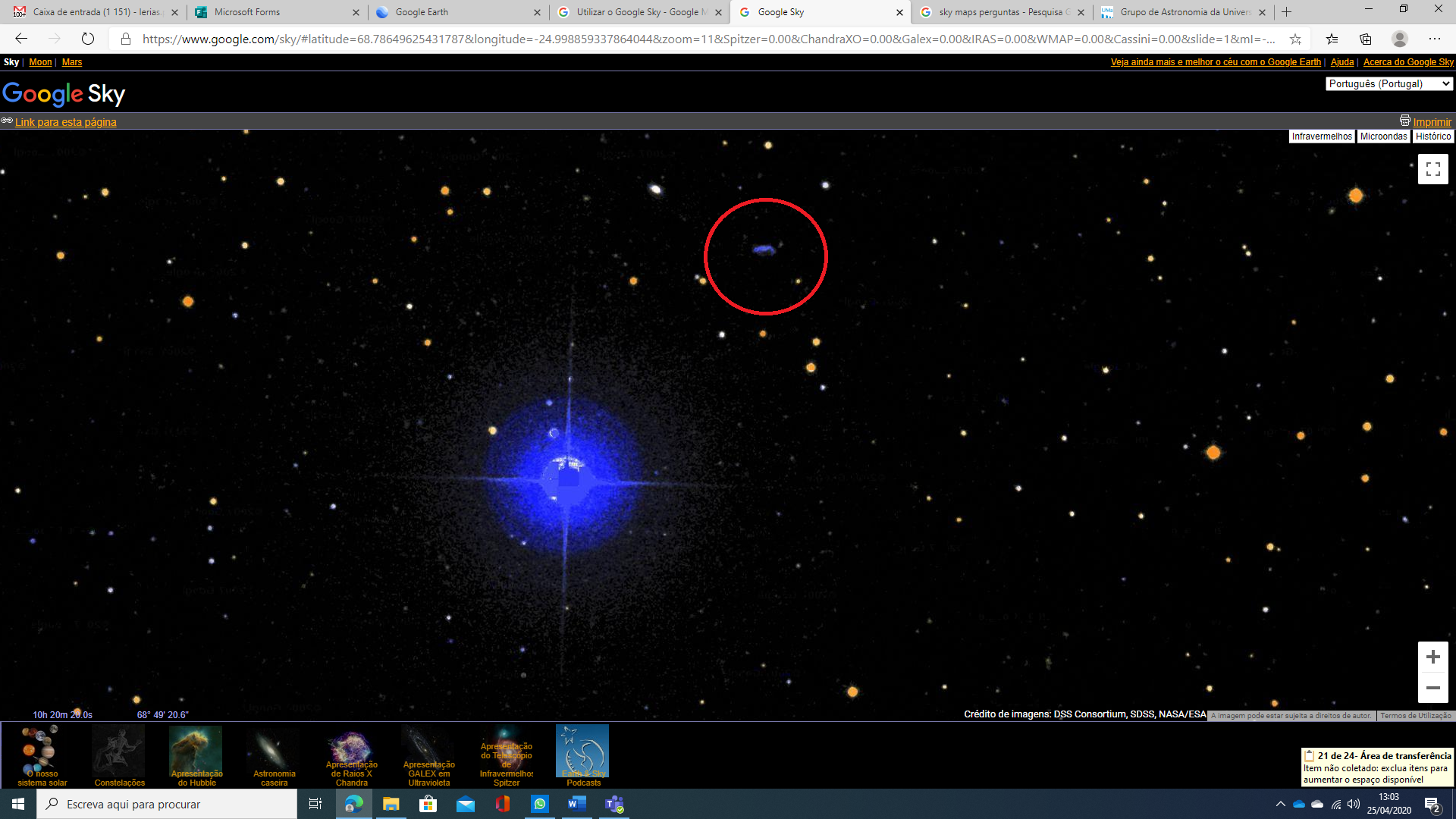Junto de uma bonita e brilhante estrela, suponho, visualizo este objeto no GoogleSky. Talvez tenha um nome e gostava de o conhecer, já que a minha busca aleatória pelo universo levou-me ao seu encontro (10h 20m 22.0s; 68º 49' 18.3''). Vê-se, abaixo do objeto, para a esquerda, a estrela HIP 50685, e, para a direita, a galáxia M81. Penso que seja um asteróide. Gostaria de perguntar se se trata de realidades físicas que podemos considerar próximas de nós e, para além dos sites de iniciação à astronomia e cosmologia, onde posso obter informação sobre asteroides recentemente descobertos.
Não se trata de um asteroide mas sim de uma galáxia. A galáxia LEDA 2724262:
https://simbad.u-strasbg.fr/simbad/sim-id?Ident=LEDA%202724262
O link anterior dá acesso a essa galáxia na base de dados SIMBAD a qual pode consultar para obter informa~ções sobre outros objetos indicando os respectivos nomes coordenadas. Outro local onde aparece informação sobre esta galáxia é na NASA/IPAC EXTRAGALACTIC DATABASE:
https://ned.ipac.caltech.edu/cgi-bin/nph-objsearch?objname=LEDA%202724262&extend=no&out_csys=Equatorial&out_equinox=J2000.0&obj_sort=RA+or+Longitude&of=pre_text&zv_breaker=30000.0&list_limit=5&img_stamp=YES
Trata-se de uma galáxia aparentemente ainda pouco documentada. Existem milhares de milhões de galáxias, apenas uma pequena fração delas está catalogada e dessas uma pequena fração estudade de forma individual. É comum encontrarmos nestes tipos de mapas celestes objetos para os quais existe pouca ou nenhuma informação (em contraste com outros como M81 para o qual exitem centenas de artigos e imagens).
Todos os corpos do sistema solar por estarem bem mais próximos do Sol parecem mover-se sobre o fundo de estrelas e galáxias distantes. Assim se o objeto em questão fosse um asteroide a sua posição em relação às estrelas vizinhas na imagem iria alterar-se ao longo dos dias. Aliás esta é uma das formas pela qual se detetam novos asteroides. Para uma lista de asteroides:
https://minorplanetcenter.net/iau/TheIndex.html
Along with a bright star, I suppose, I see this object on Google Sky. Maybe it has a name, and I would like to know it, as my random search through the Universe led me to find it (RA: 10h 20m 22.0s; Dec: 68º 49' 18.3''). You can see, below the object, to the left, the star HIP 50685, and, to the right, the galaxy M81. I think it's an asteroid. I would like to ask if these are physical objects that we can consider close to us and, in addition to astronomy and cosmology initiation websites, where I can obtain information about recently discovered asteroids.
It's not an asteroid, but a galaxy: LEDA 2724262:
https://simbad.u-strasbg.fr/simbad/sim-id?Ident=LEDA%202724262
The previous link gives access to this galaxy in the SIMBAD database, which you can query to obtain information about other objects, indicating the respective names and coordinates. Another place where information about this galaxy appears is at the NASA/IPAC EXTRAGALACTIC DATABASE:
https://ned.ipac.caltech.edu/cgi-bin/nph-objsearch?objname=LEDA%202724262&extend=no&out_csys=Equatorial&out_equinox=J2000.0&obj_sort=RA+or+Longitude&of=pre_text&zv_breaker=30000.0&list_limit=5&img_stamp=YES
It's a little documented galaxy. There are billions of galaxies, only a small fraction of them are cataloged and of those, a small fraction is studied individually. It's common to find in these types of sky maps objects for which there is little or no information, in contrast to others like M81 for which there are hundreds of articles and images.
All bodies in the Solar System, because they are much closer to the Sun, seem to move against the background of distant stars and galaxies. So, if the object in question were an asteroid, its position in relation to the neighboring stars in the image would change over the days. Incidentally, this is one of the ways in which new asteroids are detected. For a comprehensive list of asteroids, see:
https://minorplanetcenter.net/iau/TheIndex.html
